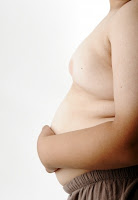 Margie King
Margie King
Activist Post
Are toys, pacifiers and even shampoo driving the epidemic of childhood obesity?
Researchers from the Children’s Environmental Health Center at The Mount Sinai Medical Center in New York have found an association between a class of chemical substances known as “phthalates” and obesity in young children.
Phthalates are man-made chemicals that disrupt your endocrine system because they mimic the body’s natural hormones. They are commonly used in building materials like plastic flooring and wall coverings, food processing materials and medical devices. They are also found in many personal-care products such as shampoos, nail polish, deodorants, fragrances, hair gels, mousses, hairsprays, and hand and body lotions. Children’s toys and some pacifiers are known to contain phthalates which help soften the plastics used in the manufacturing.
Phthalates have already been cited as a concern for menopausal women because of their endocrine disrupting properties.
Previous studies have found that use of phthalates among pregnant women can lead to a feminization of boy babies and infertility in men. Animal studies suggest they can lead to breast cancer.
This study was the first to examine the relationship between phthalate exposure and obesity in children. Published in the journal Environmental Research, the study was funded by the National Institute for Environmental Health Sciences, the National Cancer Institute, and the U.S. Environmental Protection Agency.
Mount Sinai researchers measured phthalate concentrations in the urine of 387 black and Hispanic children in New York City, and recorded body measurements including BMI, height, and waist circumference one year later. The urine tests revealed that greater than 97 percent of study participants had been exposed to phthalates typically found in personal care products such as perfume, lotions, and cosmetics; varnishes; and medication or nutritional supplement coatings.
The team found an association between concentrations of these phthalates with BMI and waist circumference among overweight children. BMI in overweight girls with the highest exposure to phthalates was 10 percent higher than those with the lowest exposure.
Prior research had already shown that exposure to these everyday chemicals may impair childhood neurodevelopment.
A subsequent study found that children with the highest levels of a particular chemical, di-ethylhexyl phthalate (DEHP), in their blood had nearly five times the odds of being obese compared with children with the lowest levels.
 The percentage of obese children aged six to 11 in the United States has grown from seven percent in 1980 to more than 40 percent in 2008, according to the U.S. Centers for Disease Control and Prevention. More than 15 percent of American children between the ages six and 19 are now characterized as obese.
The percentage of obese children aged six to 11 in the United States has grown from seven percent in 1980 to more than 40 percent in 2008, according to the U.S. Centers for Disease Control and Prevention. More than 15 percent of American children between the ages six and 19 are now characterized as obese.
Phthalates are everywhere and it’s impossible to avoid them completely.
- Look for toys and pacifiers that are advertised as phthalate-free.
- Read the labels of all personal care products and avoid anything with “phthalate” or any hyphenated version of it on the label. Also avoid anything with abbreviations of chemical names such as DBP, DEP, BzBP or DMP (in insect repellents).
- Avoid personal care products that list “fragrance” as an ingredient since that often denotes a combination of ingredients that may include phthalates.
- Only use or buy plastics with a recycling code of 1, 2 or 5. Other codes (3 or 7) are more likely to contain phthalates.
Margie King is a holistic health coach and graduate of the Institute for Integrative Nutrition®. A Wharton M.B.A. and practicing corporate attorney for 20 years, Margie left the world of business to pursue her passion for all things nutritious. She now works with midlife women and busy professionals to improve their health, energy and happiness through individual and group coaching, as well as webinars, workshops and cooking classes. She is also a professional copywriter and prolific health and nutrition writer whose work appears as the National Nutrition Examiner. To contact Margie, visit www.NourishingMenopause.com.
This article first appeared at GreenMedInfo. Please visit to access their vast database of articles and the latest information in natural health.
linkwithin_text=’Related Articles:’


Be the first to comment on "Environmental Toxins Linked to Childhood Obesity"